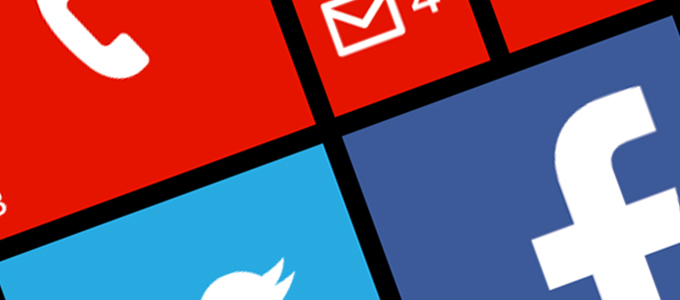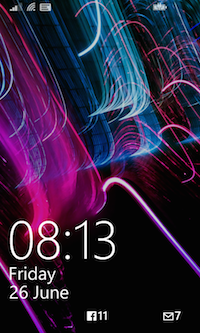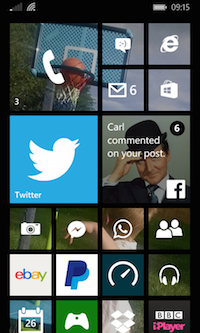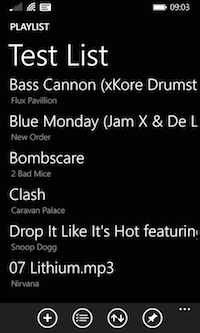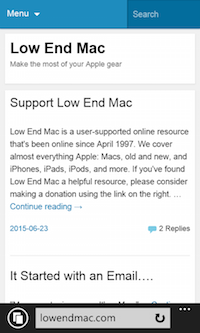I take a look at the tile-based mobile platform from Microsoft. How does it compare to other mobile operating systems?
Microsoft might have been in the mobile business for a long time,* but it wasn’t until the revamp with Windows Phone 7 and then Windows Phone 8 that Microsoft became a serious contender.
However, by this time Apple and Google had their feet well under the table, and Microsoft had their work cut out. While Windows Phone 7 wasn’t a great start, Windows Phone 8 made a huge improvement, and in 2014 the 8.1 update went even further to make the experience.
Time will tell if Windows Phone 10 goes further to expand on this.
UI
The first thing you will notice is the tile interface. After setting up your device, you are faced with a home screen of scaleable and moveable tiles. This is called your start screen.
Scroll to the bottom and find the arrow: This will open your app drawer showing all installed apps, games, and tools. You can ‘pin’ any of these to your home/start screen simply by holding down on it and selecting pin to start.
The whole OS feels very fluid and fast. I am trying this on a 2013 device, and there is a little lag at times, but nothing major – and nothing that a more powerful handset wouldn’t resolve.
Live Tiles
After you install things from the Store, set them up, and pin them to your start screen, you start to see how Windows Phone differs from other platforms. The live tile approach is a novel way of seeing updates from social media and apps at a glance.
The Twitter tile will flip, showing your latest mention/retweet. The Facebook tile will flip, showing your latest mention or comment. The Weather app shows your local weather and then flips to show a three-day forecast.
You get the idea. Notifications also come in at the top – just like iOS or Android – and can be accessed from the Notification Area by pulling down on the top of the screen.
Unified Look
One thing I did like about the entire OS is that across the whole system there is a unified look – this is also true of third-party apps. Font styles, colours, and even the options bar along the bottom is the same across different apps.
Apps & Games
The most common complaint about Windows Phone is the lack of apps and games. This might have been true in the beginning, and while it is still behind the other major platforms, I found all the major apps I normally use on my iPhone – Facebook, Twitter, eBay, PayPal, Messenger, WhatsApp, BBM, BBC iPlayer, Dropbox, and Speedtest. I even found a lot of the games my kids play.
Using It
I had a good play with it. The phone app makes and receives calls well. It plays music good enough, although the music app is far behind iOS and Android. Social media works superbly. The camera app is decent, and you can upload/share your pictures to various places including third-party apps.
The web browser is pretty good. Cortana is fun, and the rest of the system all ties together.
Cortana
You cannot use a Windows Phone device without being tempted to try out Cortana, the voice assistant for this platform. Just like Siri and Google Now, it is over-hyped, although to be fair Cortana is still in beta in most places.
It was fun to try out, and I ran the same questions on Cortana and Siri. Neither were outstandingly better than the other, both excelling in some areas and failing in others.
iCloud
I am an iPhone user, and I use the iCloud system to store my contacts and mail. I was pleased to see when setting up accounts there is an iCloud option. This makes things so much easier. I simply signed in and everything was there.
The only issue I have had so far is while I can read and write emails when deleting from my Lumia handset, the mail doesn’t seem to remove from the server, so when I load up Mail on my Mac or iPhone they are still there.
Edit: I tried replacing the mail settings with IMAP settings, and it made no difference. It seems once a mail is sent or deleted, you need to press the ‘refresh’ button.
Constant Updates
In true infuriating Microsoft style, Windows Phone is no stranger to updates. In 24 hours I had numerous updates requiring multiple restarts, these included the 8 to 8.1 update and then subsequent security updates.
Interaction with a Mac
In general, a Mac is better suited to an iPhone, taking full advantage of the Apple eco-system. However, Windows Phone has come a long way to integrate itself with Mac OS X.
First of all, the iCloud options in the Windows Phone OS grabs your contacts and mail, and then there is the Windows Phone app available from the Mac App Store to sync and manage media on your phone when connected to your Mac.
The tool is small and easy to use. One of the best functions is that it piggy-backs off of iTunes and can access playlists from there too. This means you can keep the same playlist on your iPhone as you do on your Windows Phone.
It works well. I had a few issues to begin with, but it turned out to be folder permissions. It took a little while for the tracks to appear on the phone despite the playlists being there and the Windows Phone app telling me they were there.
Pulling your images and videos across can be done in the same app too.
It’s Different
Windows Phone is a good alternative to the other two big players. People slate it for taking a different approach, but it is done well. It makes a change to have an OS that interacts in a different way.
After all, iOS and Android for all its fanatics and haters of the ‘the other one’ they are very similar. App drawer layouts and apps generally look the same. While the early days of Android saw custom skins atop such as Sense from HTC, Motoblur from Motorola and UX from Sony Ericsson – Vanilla Android especially later versions from 4.0 ‘Ice Cream Sandwich’ onwards looks closer to iOS than ever – and newer iOS takes cues from Android too.
Windows Phone and its tile approach is just a different way of getting you the information you need at a glance.
Would I Switch
I love my iPhone and iOS and even keep an older version as a spare just so I can keep using the Apple experience.
I picked up a used Lumia 620 just to play with, just to see what all the fuss is about and to see if it could be an alternative for my kids in the future.
I am one of the biggest haters of Microsoft, and I hoped that I wasn’t going to like it, but after a few hours of setting it up and using it, I started to enjoy using it. It didn’t seem clunky; it was fluid, consistent, and well thought out.
I can’t ever see me using ditching my iPhone for a Lumia. I could use it for a few days, but I am too much of an Apple fan and lover of their total integration system. I have spent too many years using Mac OS X and iOS. I know it and love it inside out.
Conclusion
Windows Phone is a good approach, and it has matured into a better platform over time. It might not be to everyone’s liking, but it is a good, fast alternative that can give you a great experience even on lower-end hardware. Top that with very reasonably priced handsets, and you have an appealing option.
Check out my review of the Nokia Lumia 620. It takes a look from a hardware point of view.
* The Windows Phone OS has a long history. Its roots go back to Windows CE, first released in 1996, which gave birth to Pocket PC in 2000. This evolved into Windows Mobile 2003, 5.0 in 2005, 6.0 in 2007, 6.1 in 2008, and 6.5 in 2009. It took the name Windows Phone in 2010 with the release of Windows Phone 7.
Follow Simon Royal on Twitter or send him an Email.
Like what you have read? Send Simon a donation via Tip Jar.
Keywords: #windowsphone #techspectrum #simonroyal
Short link: http://goo.gl/eGwppt
searchwords: windowsphone

